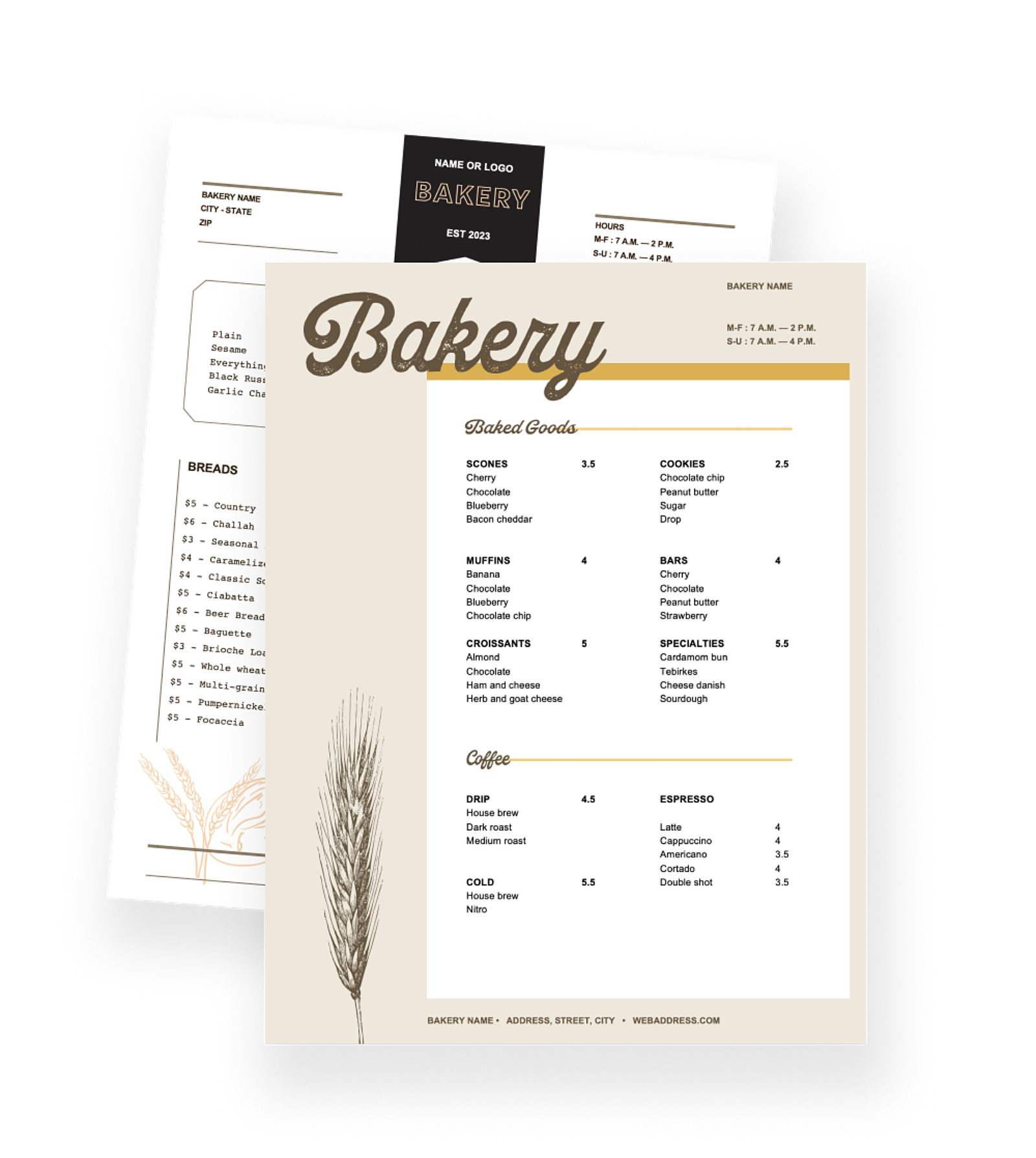
Bakery Recipes: How to Develop Bakery Recipes [2024]
Creating new and unique baked goods for your bakery’s menu is key for standing out and attracting customers. Learn how to develop bakery recipes here.

Caroline PriceAuthor


Bakery Menu Templates
Use these bakery menu templates as a starting point for your menu design or to give your menu a refresh.
Get free downloadWhile your bakery probably has a few tried-and-true signature items, menu innovation is a great way to stand out from the competition.
Even more importantly, it’s key to meeting the ever-changing demands of customers. Jim Doak, chef and culinary consultant at Corner Bakery Cafe, wrote for Fast Casual that “66% of consumers like to try new flavors from time to time. They don't want to eat the same thing they had earlier in the week, or even the week prior.”
Even if you do have that one cookie, cake, or pastry that everyone loves, it’s still important to keep your menu fresh and exciting by offering other tasty alternatives. After all, this could encourage customers to shop at your bakery more often.
So, in this article we’ll explore how to develop bakery recipes, from finding inspiration to conducting taste tests. By the end, you’ll have a good idea of how to create new menu items that get customers excited to visit your bake shop.
Key takeaways
Before you start developing new recipes, it’s vital to define your bakery’s concept. This will influence every aspect of your recipe development process.
You can find recipe inspiration in a myriad of places, including industry trend reports, online influencers, local bakeries, and baking festivals.
As you research new bakery recipe ideas, be sure to create a list and track all the key information for each one to stay organized and narrow down the best options.
Start with basic versions of each recipe to nail the fundamental flavors before experimenting with new ingredients and baking techniques.
Be sure to test and retest your new bakery recipes to ensure each one meets a high standard that customers will love, keeping them coming back for more.
Menu Engineering Course
Take this course to make the most of your menu. Learn about menu psychology and design, managing your menu online, and adapting your menu to increase sales.

Define your bakery concept
Before you start developing your new bakery recipes, it’s key that you have a clear and distinct concept. This will allow you to create a cohesive menu and help you stand out from the competition.
Ultimately, your concept will influence every step of your recipe development process.
Identify your target market
To develop your bakery concept, it’s key that you determine the demographics of your target market. For example, they might be:
Office workers looking for quick breakfast pastries
Families seeking celebratory cakes
Food enthusiasts craving gourmet desserts
Remember, understanding your audience will help tailor your menu to their tastes and preferences, whether it's offering indulgent brownies or healthier options like zucchini bread.
Choose a specific bakery style
Once you know who your target customers are, you should choose a specific style. For example, you might opt to focus on:
Traditional American baked goods (ie, cookies, brownies, etc.)
European pastries (ie, French croissants, Italian cannolis, etc.)
Mediterranean desserts (ie, baklava, Turkish lokum, etc.)
Of course, you might also go with a fusion of different styles. For instance, you could blend classic French patisserie techniques with American flavors. This could produce a unique menu including items like red velvet croissants.
Determine your unique selling proposition (USP)
To stand out from the competition and give customers a reason to come in, it’s vital to identify what sets your bakery apart. For example, this could be a:
Signature cake recipe
House-made ice cream for pairings
Particular ingredient sourcing method
Ultimately, your USP should resonate with your target market, and you should reflect it in your recipes. For instance, your bakery might be known for its artisanal sourdough bread or its use of locally-sourced, organic ingredients in fruit pies.
Consider dietary restrictions
It’s also important that you cater to various dietary needs so you reach a larger customer base. For example, you’ll likely want to include options that are:
Vegetarian
Vegan
Gluten-free
Low-sugar
Remember, offering a variety of options ensures that all customers feel welcome and can find something they enjoy, from classic buttery shortbread cookies to innovative gluten-free alternatives.
Research recipe ideas
Now that you’ve got a great concept together, you can start looking for recipe ideas that may fit with it.
So, be sure to keep the following tips in mind as your search for inspiration for your own bakery.
Explore baking trends
Firstly, it’s a good idea to stay up-to-date on current baking trends and popular flavors by subscribing to industry reports and publications.
Once you’ve got your finger on the pulse of the baking industry, you can explore how you can adapt these trends to your own business.
For example, you might think about incorporating unique ingredients like zucchini into bread recipes. Likewise, you might find inspiration for creating gluten-free versions of favorite treats to cater to health-conscious customers.
Visit local bakeries and markets
Of course, you should also consider spending time at local bakeries to understand the competitive landscape, as well as what makes them successful. As you visit other businesses, be sure to observe things like:
Best-selling items
Customer preferences
Unique twists on traditional recipes
Presentation styles
Portion sizes
Interesting flavor combinations
Additionally, consider visiting farmers’ markets to discover local ingredients. This can be a great way to inspire new recipes and seasonal specials, such as fresh apple pie in the fall.
Follow baking-focused influencers
Food blogs and social media influencers specializing in baking can be another great source of ideas.
For instance, platforms like Instagram and Pinterest not only provide visual inspiration, but can also highlight emerging trends in baking.
So, think about looking for innovative takes on classic dishes, such as no-bake cheesecake variations or creative uses for peanut butter in dessert recipes.
Attend baking festivals and events
One more great way to find recipe inspiration is attending baking festivals and culinary events showcasing innovative takes on classic treats. These events provide opportunities to network with pastry chefs and other food enthusiasts.
Better yet, you can gather new ideas and insights into potential menu items for your bakery.
For example, a holiday-themed baking festival might inspire new Christmas cookie recipes or festive cake ideas.
3. Brainstorm initial recipe ideas
After doing some research, it’s time to start brainstorming some initial recipe ideas.
This process will help you narrow down potential menu items that fit with your concept so you can start putting your own twist on them.
List potential baked goods that fit your concept
The first thing you'll want to do is create a shortlist of baked goods that align with your bakery’s theme. For instance, a bakery focusing on American classics might offer a range of cookie recipes, from chewy chocolate chip cookies to crispy sugar cookies with festive sprinkles.
When making your list, consider using a spreadsheet and tracking key information for each recipe, like:
Recipe name
Category (ie, bread, pastry, cake, cookie, etc.)
Ingredients
Prep time
Seasonality
Popularity potential
By tracking key information for each recipe, you’ll have an easier time organizing them and narrowing down which may work best for your bakery.
Consider seasonal ingredients and local produce
It’s also a good idea to incorporate seasonal ingredients and local produce to ensure freshness and support local farmers.
Better yet, this approach can also inspire seasonal specials that keep your menu exciting for returning customers.
For example, a summer menu might feature fresh berry scones and lemon tarts, while a fall menu could highlight pumpkin spice muffins and pecan pies.
Think about menu diversity
One more thing to keep in mind as you create your initial list of potential bakery recipes is menu diversity. After all, a well-rounded bakery menu will likely include a variety of options, such as:
Sweet and savory items
Celebratory items (ie, birthday cakes)
Everyday treats
Additionally, it’s a good idea to ensure you have options for different times of the day and events. This could be quick grab-and-go breakfast items, like coffee cake, as well as elaborate custom cakes for special occasions.
Just remember, of course, to keep your offerings inline with your theme. For instance, if your bakery focuses mostly on baklava, don’t feel compelled to offer American-style birthday cakes. However, you could get creative and develop a birthday baklava cake!
4. Develop new recipes
Now that you’ve got your list of potential recipes together, you’re ready to start putting your own twist on them.
As you begin developing new and unique items for your menu, be sure to think about the following advice.
Start with basic versions of each baked good
It’s generally a good idea to begin with simple, basic versions of your baked goods. This will allow you to nail the fundamental flavors and techniques before experimenting with more complex variations.
For example, start with a classic vanilla cupcake recipe before adding unique flavors or elaborate frostings.
Experiment with different ingredients and techniques
From there, you can start testing out different ingredients and baking techniques to enhance your creations.
For example, try various types of chocolate for your brownies, or different methods for achieving the perfect chewy texture in your cookies.
You may also want to experiment with different baking temperatures and times to find the best approach for each recipe, whether it’s creating a fudgy brownie or crispy cookie.
Balance flavors, textures, and presentation
A visually-appealing baked good with a well-rounded taste profile will leave a lasting impression.
Remember, though, that while presentation is important, taste and texture are just as crucial. As Duff Goldman, pastry chef and star of the television show Ace of Cakes, said in an interview with Tasting Table:
“Before you even think about [decorating], it's got to be good. It's got to be good, because if the cake's not good and you get this beautiful cake — it looks like an elephant or whatever — and then you cut it open and it's dry, what was the point? First of all, what's the point of destroying this beautiful work of art that somebody made when it's not even that good? Second of all, it's a cake. The fundamental purpose for a cake existing is to be eaten. They got to be good, right off the bat.”
Keep portion sizes and pricing in mind
Lastly, it’s important to ensure your portion sizes are appropriate and pricing is competitive. Bakeries should offer good value, and finding this balance is crucial.
So, be sure to analyze your costs and set prices that ensure profitability while providing value to customers, whether it's for individual treats like cupcakes or larger items like celebration cakes.
5. Test and refine your recipes
Before offering your new creations to customers, it’s important to make sure everyone will love them!
So, be sure to keep the following tips in mind to test your recipes and ensure they meet high standards.
Conduct taste tests
Firstly, conduct taste tests with friends, family, staff, and even some of your loyal customers. Their feedback can provide valuable insights into what works and what needs improvement.
When conducting the tests, be sure to create a feedback form so you can gather specific comments on:
Flavor
Texture
Presentation
Overall satisfaction
This information is essential for making necessary adjustments. So, pay attention to recurring comments and be willing to make changes based on their feedback.
For example maybe you should adjust the sweetness of your buttercream or the chewiness of your oatmeal raisin cookies.
Make adjustments and retest
Once you make adjustments based on the feedback, it’s important to retest your recipes. This iterative process will help you achieve the perfect balance of taste and quality, and ensure your new items are ready to take their place on your menu.
For example, if testers find your cheesecake is too dense, continue to adjust the recipe and retest until it reaches the right texture and flavor profile.
Ensure consistency
Lastly, it’s key to ensure consistency with each batch of your recipes to ensure they always meet a high standard. After all, consistency is key to building a loyal customer base.
So, be sure to develop standardized recipes that you can train your staff to follow precisely. This will ensure your bakery prepares and presents each item consistently, whether it’s a batch of chocolate chip cookies or wedding cakes.
6. Source your ingredients
At this point, you’ve perfected your new recipes, and you should be excited to share them with the world! However, before you can add them to your menu, you first need to secure your ingredients.
So, be sure to consider the following tips as you source your ingredients so you can start scaling up your recipes.
Find reliable suppliers
Establishing relationships with reliable suppliers is key for securing fresh and high-quality ingredients consistently.
So, be sure to look for suppliers who share your commitment to quality and can deliver on-time.
After all, it’s vital that you have a steady stream of key ingredients like flour, butter, eggs, and chocolate.
Build relationships with local farmers and markets
It’s also a good idea to build relationships with local farmers and markets. This not only ensures you have access to the freshest ingredients, but also fosters community connections and sustainability.
By attending farmers’ markets, you can build relationships with local suppliers and secure the best ingredients for your bakery. This can be especially beneficial for seasonal ingredients, like fresh fruits for pies and cobblers.
Consider cost-effectiveness
While ingredient quality is most important, it’s also key to find cost-effective options to ensure your business is profitable. Fortunately, you can help manage costs by:
Bulk purchasing
Negotiating with suppliers
Working with multiple suppliers to find the best prices without sacrificing quality
For example, you might source your flour from one supplier and your dairy products from another to ensure the best quality-to-price ratio.
Plan for ingredient availability and seasonality
Finally, it’s a good idea to plan your menu around the availability and seasonality of ingredients to maintain quality and keep costs more manageable.
Creating a seasonal menu that highlights the freshest ingredients available not only ensures your baked goods are always at their best, but also keeps your menu fresh and exciting for customers.
For example, you might offer cranberry scones only during the holiday season, or feature a peach galette in the summer.
7. Scale your bakery recipes
Now that you’ve got your recipes perfected and your ingredients secured, it’s time to start scaling up your recipes so you can serve all of your hungry customers!
As you think about how to best produce large quantities of your baked goods, be sure to keep the following advice in mind.
Adjust ingredient quantities for larger batches
Ensuring consistency in taste and quality as you modify your recipes to accommodate larger batch sizes is essential. So, be sure to use precise measurements and scaling techniques to maintain the integrity of each baked good.
Additionally, you should develop a standardized process for preparing and presenting each item to maintain consistency in taste and appearance.
So, consider creating detailed recipe cards and training materials for your kitchen staff to follow. This might include specific instructions on how to decorate cupcakes or assemble layer cakes.
Develop an efficient prep and baking system
It’s also important to create an efficient prep and baking system that allows for smooth production without compromising quality. This might include:
Pre-measuring dry ingredients
Organizing your kitchen layout for optimal workflow
Streamlining baking processes to handle peak times effectively
For example, you might prepare cookie doughs in advance and refrigerate them for easy baking throughout the day.
Consider storage and display limitations
Finally, you should be mindful of storage and space limitations. To make the most of your available space, be sure to optimize your kitchen layout and display cases to ensure smooth operations and attractive presentations.
Additionally, it's important to invest in proper storage equipment and organize your pantry and refrigerators to maximize efficiency.
For instance, you might consider using tiered display stands for cupcakes or investing in temperature-controlled cases for delicate pastries.
Start developing your bakery recipes
Developing bakery recipes requires a careful balance of creativity, culinary skill, and business sense. After all, it’s vital that your bakery provides unique items that taste amazing while still turning a profit.
By following the steps in this guide, you’ll be well on your way to creating a menu of delicious, innovative baked goods that satisfy even the most discerning sweet tooth, setting your business apart.
However, while your recipes are key to your bakery’s success, there’s more to running a successful business than just your menu. It’s also crucial that you have the right tools to streamline your operations, as well as provide an excellent customer experience.
Fortunately, with Toast’s comprehensive POS system, you can accomplish both of these things. From inventory management and payroll to loyalty programs and online ordering, Toast has all the features you need to take your business to the next level.
To learn all the ways a POS system can help you run a better bakery, be sure to check out all of the awesome features!
Bakery Menu Templates
Use these bakery menu templates as a starting point for your menu design or to give your menu a refresh.

Related Resources
Is this article helpful?
DISCLAIMER: This information is provided for general informational purposes only, and publication does not constitute an endorsement. Toast does not warrant the accuracy or completeness of any information, text, graphics, links, or other items contained within this content. Toast does not guarantee you will achieve any specific results if you follow any advice herein. It may be advisable for you to consult with a professional such as a lawyer, accountant, or business advisor for advice specific to your situation.
Read More
Subscribe to On the Line
Sign up to get industry intel, advice, tools, and honest takes from real people tackling their restaurants’ greatest challenges.



